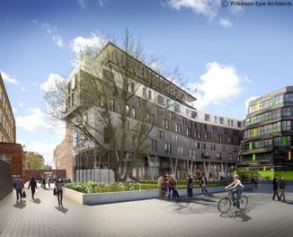Bouygues UK has been awarded a £27 million contract to provide a new graduate facility as part of Queen Mary University of London (QMUL)’s main teaching campus in Tower Hamlets.
The building will provide a vital research and teaching resource for the university and its growing number of postgraduate students; with large amphitheatre-style teaching areas and 63 offices dedicated to supporting postgraduates with their studies at the Mile End Road campus.
The university’s School of Economics and Finance will also relocate to the new building, which will include a cafe, lecture theatre and seminar rooms as well as a common room and terrace.
Bouygues UK’s Managing Director for Construction London, Arnaud Bekaert, said: “We are delivering a new building, on a busy student campus, in close proximity to London Underground – each of which presents different, simultaneous challenges for us during the construction phase.
“The eight-storey facility will be built with two concrete cores and feature a 750 tonne steel frame with a brick facade and curtain wall. The building has an irregular facade so it is not uniform in design.
“Due to its proximity to the Central Line, the building has also had to incorporate features to absorb and minimise vibrations from the trains using the underground, as have our construction methods. All in all, it is an exciting and complex project.”
As part of the project, Bouygues UK is once again collaborating with architects WilkinsonEyre; the companies previously worked together on the multiple award-winning Mary Rose Museum.
Project Manager Lead, Julie Crossen, Sweett Group said: “We are extremely pleased to have Bouygues UK as part of the project team to deliver the new Graduate Centre. Through our combined experience and established relationship, and working closely with the design team, we will deliver a state-of-the-art facility for QMUL.”
Enabling works have already been carried out on the site. The project is scheduled for completion in time for late 2016.









